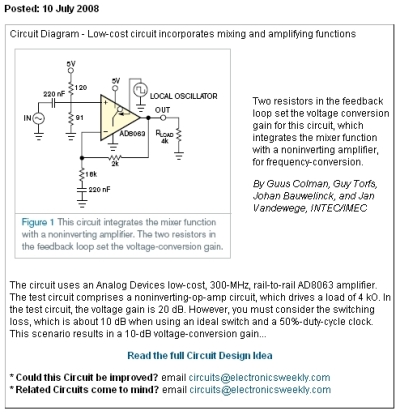
Capacitance-circuits

Gadget Master provides the latest updates on capacitance circuits in a compilation of capacitance circuit projects and websites tailored for electronics designers, scientists, and engineers.
Capacitance circuits are fundamental in various electronic applications, serving critical roles in timing, filtering, and energy storage. These circuits utilize capacitors to store electrical energy temporarily, which can be released when needed. The design of capacitance circuits often involves understanding the relationships between capacitance, voltage, and charge, as described by the formula \( Q = C \times V \), where \( Q \) is the charge in coulombs, \( C \) is the capacitance in farads, and \( V \) is the voltage in volts.
A typical capacitance circuit can include components such as resistors, inductors, and operational amplifiers, depending on the application. For example, in a simple RC (resistor-capacitor) circuit, the capacitor charges through the resistor, and the time constant of the circuit, given by \( \tau = R \times C \), determines how quickly the capacitor charges and discharges. This is crucial in timing applications such as oscillators and pulse generators.
In more complex circuits, such as those found in audio equipment or signal processing, capacitors are used in conjunction with inductors to create filters that can allow certain frequencies to pass while attenuating others. These filters can be passive or active, with active filters incorporating operational amplifiers to enhance performance.
For electronics designers and engineers, understanding the various types of capacitors (e.g., ceramic, electrolytic, tantalum) and their characteristics is essential for selecting the right component for a specific application. Each type of capacitor has its advantages and limitations in terms of capacitance range, voltage rating, equivalent series resistance (ESR), and temperature stability.
Furthermore, the exploration of capacitance circuits extends to innovative applications, such as energy harvesting systems, where capacitors can store energy from ambient sources like solar or kinetic energy. As technology advances, the integration of capacitors within smart devices and IoT (Internet of Things) applications continues to grow, emphasizing the importance of capacitance circuits in modern electronics design.
Overall, capacitance circuits are a vital area of study and application in electronics, with ongoing developments contributing to more efficient and effective designs across various fields.Gadget Master brings you the latest news on capacitance-circuits in our round-up of capacitance-circuits projects and websites for electronics designers, scientists and engineers 🔗 External reference
Capacitance circuits are fundamental in various electronic applications, serving critical roles in timing, filtering, and energy storage. These circuits utilize capacitors to store electrical energy temporarily, which can be released when needed. The design of capacitance circuits often involves understanding the relationships between capacitance, voltage, and charge, as described by the formula \( Q = C \times V \), where \( Q \) is the charge in coulombs, \( C \) is the capacitance in farads, and \( V \) is the voltage in volts.
A typical capacitance circuit can include components such as resistors, inductors, and operational amplifiers, depending on the application. For example, in a simple RC (resistor-capacitor) circuit, the capacitor charges through the resistor, and the time constant of the circuit, given by \( \tau = R \times C \), determines how quickly the capacitor charges and discharges. This is crucial in timing applications such as oscillators and pulse generators.
In more complex circuits, such as those found in audio equipment or signal processing, capacitors are used in conjunction with inductors to create filters that can allow certain frequencies to pass while attenuating others. These filters can be passive or active, with active filters incorporating operational amplifiers to enhance performance.
For electronics designers and engineers, understanding the various types of capacitors (e.g., ceramic, electrolytic, tantalum) and their characteristics is essential for selecting the right component for a specific application. Each type of capacitor has its advantages and limitations in terms of capacitance range, voltage rating, equivalent series resistance (ESR), and temperature stability.
Furthermore, the exploration of capacitance circuits extends to innovative applications, such as energy harvesting systems, where capacitors can store energy from ambient sources like solar or kinetic energy. As technology advances, the integration of capacitors within smart devices and IoT (Internet of Things) applications continues to grow, emphasizing the importance of capacitance circuits in modern electronics design.
Overall, capacitance circuits are a vital area of study and application in electronics, with ongoing developments contributing to more efficient and effective designs across various fields.Gadget Master brings you the latest news on capacitance-circuits in our round-up of capacitance-circuits projects and websites for electronics designers, scientists and engineers 🔗 External reference